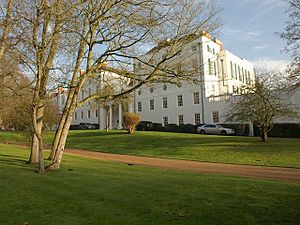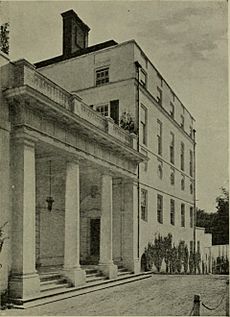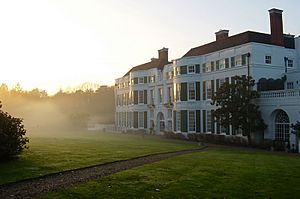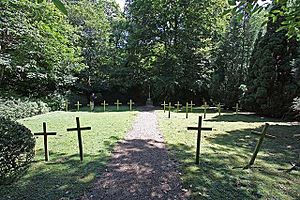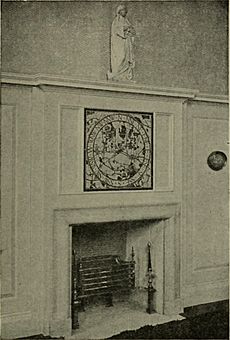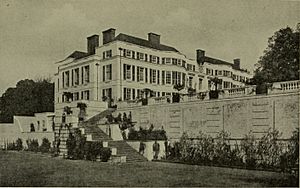Nashdom facts for kids
Nashdom, also known as Nashdom Abbey, is a large, historic building in Burnham, England. It was designed by a famous architect named Edwin Lutyens in a style that looked like older, grand houses. Nashdom was first a fancy home, then it became a place where Anglican Benedictine monks lived. Today, it has been turned into apartments. Both the building and its beautiful gardens are considered very important and are officially listed as historic sites.
Contents
A Grand Country Home
Who Lived Here First?
The name Nashdom comes from Russian and means "our home". This makes sense because the house was built for Prince and Princess Dolgorouki, who were from Russia. Prince Alexis used to work for the Russian royal family. In 1898, he married Frances, who was the daughter of a rich Scottish shipping businessman. They already had other homes in Scotland and London, but the Princess wanted another house. She wanted a special place to host royal guests and big parties.
Architect Edwin Lutyens visited the site in 1905. The Princess had a budget, but Lutyens thought her dream house would cost more. They finally agreed on a design that cost about £15,000. The house was finished sometime between 1908 and 1911. The Prince passed away in 1915, and the Princess died in France in 1919. She left Nashdom for her family to use.
The House's Design
Lutyens built Nashdom in a style called Neo-Georgian. This means it looked like the grand houses built during the Georgian era, but it was new. The house was made of whitewashed brick. Because the land sloped steeply, Lutyens built a basement level under part of the house.
The front of the house, facing the road, looked very grand and formal. It had tall columns and a special entrance porch. Inside this porch, the main door was actually on the left, leading to the entrance hall.
The entrance hall had two staircases. The main one was very wide and led up to the "Big Room," which was used for entertaining guests. Another staircase led to the rooms facing the garden. On a grand landing, there was a cool feature: a wind dial on the wall! It showed the wind direction on a local map and was connected to a weathervane on the roof.
The back of the house, facing the garden, looked different from the front. It had many sash windows with green shutters, placed very close together. Along this side, there were several interesting rooms. These included a large "Big Room," a round drawing room with a big curved window, and a glass-domed hall called the "Winter Garden." There was also a dining room and a smoking room. The curved windows continued up the building, and the round drawing room even had a circular bedroom above it!
Nashdom as an Abbey
Monks Find a New Home
A group of Anglican Benedictine monks, who had been living at Caldey Abbey, needed a new place to live. Most of their community had become Roman Catholic in 1913, but a small group wanted to remain Anglican. They first moved to Pershore Abbey.
In 1924, the monks learned that Nashdom was available for sale. They bought the house for £8,000. In September 1926, the community of monks moved into Nashdom, making it their new abbey.
Life at the Abbey
Nashdom Abbey became an important center for Anglican monks who followed some Roman Catholic traditions. A famous scholar named Gregory Dix, who studied church services, joined the community in 1926. He became a leader there and was buried in the abbey cemetery when he died in 1952.
Another notable person at Nashdom was Anselm Hughes, who was the abbey's music director for many years. He also became a leader in the community.
Starting a New Abbey in America
In 1935, Nashdom Abbey helped train a group of American church members. These Americans later started their own monastic community in the United States. In 1939, they founded St Gregory's House in Indiana, which later moved to Michigan. This American community was connected to Nashdom until 1969, when it became its own independent abbey.
Moving On
By 1987, the community of monks at Nashdom had become smaller. They decided to move to a new location called Elmore Abbey, near Newbury. There, they built a new abbey church, which was finished in 1995. Justin Welby, who later became the Archbishop of Canterbury, often visited the abbey and even became a special member of the Benedictine community in 2004.
In 2010, the remaining four monks moved again. They went to live in a house at Sarum College in Salisbury Cathedral, where they planned to build a small chapel.
Nashdom Today: Apartments
In 1997, Nashdom and its other buildings were changed into an apartment complex. The main house was divided into 15 apartments. Even though much of the inside was changed, some original features were kept. The cool wind dial on the landing was saved, along with a bust (a sculpture of the head and shoulders) of Princess Dolgorouki. The complex now includes a swimming pool, tennis court, and a gym for the residents.
The Beautiful Gardens
Nashdom has about 4 hectares (about 10 acres) of grounds. The house sits at the northern end of these grounds. The garden side of the house looks out over a large lawn. Along one side of this lawn, there is a very tall retaining wall, about 20 feet high, with a fancy railing on top. A big stone stairway goes down from this wall to what used to be another lawn, but is now a car park.
From the main lawn, a path leads south into a wooded area filled with rhododendrons. The small cemetery where the monks were buried is also among these trees.
Several parts of the gardens were also designed by Lutyens and are considered historic. These include the wall around the rose garden, a stable, a gatehouse, and a special alcove.


